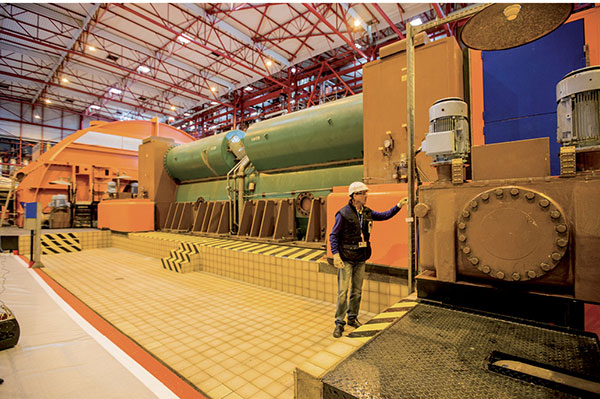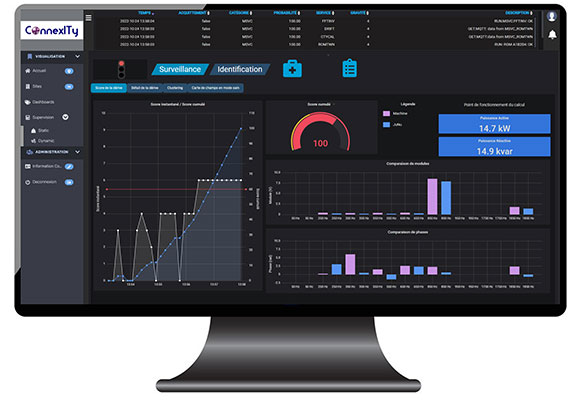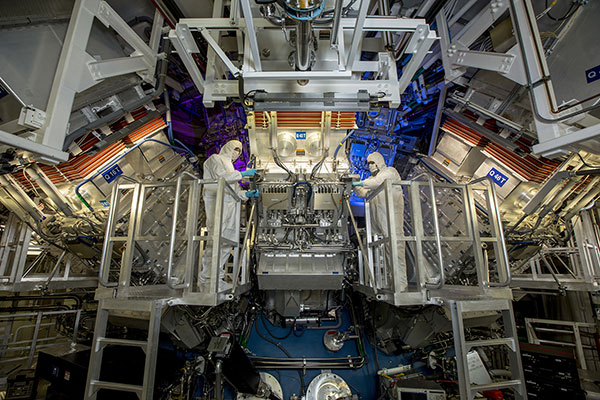
In the engine room of unit 2 of the Penly Nuclear Powerplant, the technician works on a control panel adjoining the alternator. In perspective and in the background are the turbines. Image courtesy of Électricité de France.
April 6, 2023
If you’re thinking about building a digital twin of a turbo generator, there’s good news. The ConnexITy Consortium, led by the French utility firm Électricité de France (EDF), has already built a template.
Last year, Ansys announced on its blog, “ConnexITy is using Ansys Twin Builder to design a digital twin of the turbo generator that optimizes maintenance and operation.”
The model can:
- Monitor: Detect drift with respect to normal asset behavior.
- Identify: Predict root cause of the drift.
- Confirm: Verify that the predicted failure mode reflects the actual normal asset behavior.
- Advice: Provide maintenance guidelines and insight.
Blueprint of a Turbo Generator
ConnexITy designed and tested its technology at ConnexLab, located on the Saclay Plateau, 12 miles south of Paris.
Ansys points out, “The turbo generator’s digital twin can predict the health state of the generator in real time by learning from sensor data and reduced order models (ROMs) of transient electromagnetic behavior. It also uses embedded defect classifiers based on support vector machines (SVMs) to predict probable failure modes. In machine learning (ML), SVMs are supervised models with algorithms that analyze and classify data. In addition, the twin is integrated into Atos’ Codex Smart Edge—an industrial internet of things (IIoT) platform—with a web dashboard that allows visualization and interaction between operators and experts.”
A digital twin is a virtual representation of a connected physical asset and encompasses its entire product lifecycle, as defined by the Aerospace Industries Association (“Digital Twin: Definition & Value: An AIAA and AIA Position Paper,” February 9, 2021). Fabien Leray, ConnexITy project leader, embraces this definition.
ConnexITy’s parent firm EDF operates 58 nuclear power plants scattered across France, with a few more in the U.S. and UK.
“Each generator was built on demand,” explains Leray, which results in “slight variations in the fabrication process, like metal thickness, wire space [and] sensor accuracy. So, we had to create a generic model for a digital twin with wide tolerances in the algorithms, find out which variation could impact the simulation results, and adapt and fit the model for each specific generator.”
Growing Use of Machine Learning
EDF’s plan is to first use the turbo generator’s digital twin internally to validate results. This involves building a twin for each operational turbo generator. Once the model is proven to offer good values, it plans to bring it to the market as a configurable digital twin template, according to Leray. Eventually, EDF hopes to develop digital twin templates for other nuclear power plant components as well.
“The Ansys Twin Builder technology is an essential component in our digital twin,” says Leray. “We used Twin Builder to create reduced order models, using aggregated simulation results. This reduced order model is at the core of the digital twin. We also use our own product, code_Carmel, for simulation. It’s a large data set, so we had to use machine learning.”
As simplified representation of aggregated simulation results, ROMs take less time and computation to process. In contrast, full physics-based simulation tends to take much longer due to the number of calculations involved. With the rise of artificial intelligence and machine learning, Ansys and other leading simulation software makers are expected to explore the use of ROMs in their products.
Ansys describes Twin Builder as a technology to create “simulation-based digital twins with hybrid analytics.” Twin Builder is based on Ansys’ in-house simulation technology. When needed, it incorporates the partners’ advanced modeling features and libraries, says Sameer Kher, senior director R&D, Digital Twin at Ansys.
Twin Builder is licensed in a combination of lease or subscription and upfront fees. “Our digital twin solutions intensify usage of our core products. For example, creating a twin for each type of furnace requires tens of executions of our [computational fluid dynamics] products. We are agnostic to the deployment environment. We typically deploy to customers’ IoT or cloud stacks or on-premises hardware,” Kher says.

Ansys’ cloud-friendly licensing accounts for incremental usage, which is particularly suited for digital twin development.
Nuclear Reactors Going Virtual
In a white paper titled “The Virtual Nuclear Reactor,” Siemens Digital Industries Software suggests, “By adopting a comprehensive digital twin (or virtual reactor) methodology, it is possible both to cut in half the design cycle for new nuclear technology and greatly reduce the cost of testing required to support licensing. Moreover, without the extensive use of digital twin technology, many of the next-generation reactor designs will never make it through the licensing and commissioning phase.”
The white paper focuses on “the high-fidelity digital twin that is a living breathing facsimile of your nuclear reactor.” It proposes a digital replica built using Simcenter STAR-CCM+ software, from the Siemens Xcelerator portfolio. An early example of the digital twin comes from X-Energy, which was selected by the U.S. Department of Energy for the Advanced Reactor Demonstration Program (ARDP). X-Energy says it’s currently focusing on Gen-IV high-temperature gas-cooled reactors (HTGR) as the technology of choice. It runs HTGR pebble-bed design programs in Germany and South Africa.
The white paper points out, “During the design phase, it was critical that X-Energy was able to predict the temperature in both fluids and solids simultaneously, including the influence of all modes of heat transfer: conduction, convection and radiation. Using traditional one-dimensional network techniques, it would be simply impossible to optimize all these components, as the temperature uncertainty in the components would be much too high to satisfy the licensing authorities … The only way of eliminating these uncertainties [short of building an expensive full-scale demonstrator] is by using a high-fidelity three-dimensional twin.”
To model the pebble bed, Siemens collaborated with Netherlands-based NRG. The goal was to build a “high-fidelity simulation of the pebble bed, and then to use that as a testbed to validate more practical lower-order models that could be deployed in a digital twin,” according to the paper’s authors.
CAD Model as the Foundation
PTC, known for its Creo design and simulation software suite, has a long history serving the National Ignition Facility (NIF) at Lawrence Livermore National Laboratory (LLNL), stretching over 25 years. At the time, Creo was known by its previous name, Pro/ENGINEER.
Jim Heppelmann, president and CEO of PTC, wrote in his blog post in December 2022, “When I joined PTC back in 1998, the NIF had already selected our Pro/ENGINEER CAD software ... A few years later, the NIF team added Windchill to the solution as their data management needs grew.”
Heppelmann is particularly proud of the fact that the NIF has used PTC design and data management software to model the massive NIF machine that generates fusion ignition—Everything “except the walls and the bathrooms,” he wrote. The assembly involves “more than 3.5 million components, comprised of around 750,000 unique part designs,” he noted. In December 2022, the LLNL team announced they had conducted the first controlled fusion experiment in history at the NIF.

The National Ignition Facility (NIF) is believed to be the largest Creo and Windchill assembly ever created. Image courtesy of Lawrence Livermore National Laboratory.
Could a CAD model qualify as a digital twin? Heppelmann quips, “If you ask 50 people for their definition, you’ll get 50 different responses,” and adds, “If you accept that a CAD model can serve as a digital twin at a baseline level because it’s the 3D representation of the product/assembly, this would qualify. If your definition includes elements of IoT and operational feedback, we would classify this assembly as a CAD model.”
Heppelmann clarified the NIF’s Windchill deployment is on-premise, with the assembly stored locally. The NIF’s development included simulation-driven design for the mechanical components of the assembly. Creo Simulate was used as part of this work, he points out.
Design and simulation software titans are anticipating a need for digital twins in general, but specifically for industries with large, costly assets. The energy sector fits the bill.
Another large-scale nuclear fusion simulation is going on at the University of Manchester in conjunction with the UK Atomic Energy Authority (UKAEA), where researchers are leveraging the NVIDIA Omniverse platform to design and develop a full-scale fusion power plant and its digital twin.
Using Omniverse Enterprise, the team was able to import full-fidelity 3D data, and visualize in real time using the Omniverse RTX Renderer. For fusion plasma simulations, the teams also developed Python-based Omniverse Extensions to incorporate data from Monte Carlo Neutronics Code Geant4 simulation software. The engineers also built Omniverse Extensions to ingest and view JOREK plasma simulation code, which simulates visible light emissions, and are evaluating the NVIDIA Modulus AI-physics framework to develop AI surrogate models to accelerate the fusion plasma simulations.
When and if a fusion reactor is constructed, an Omniverse-based digital twin could help provide real-time operational monitoring of the power plant’s physical state, and allow researchers to test out changes or improvements to the reactor virtually.
“Digital twins can provide improvements throughout the lifecycle of modular nuclear reactors from initial development to operation and even decommissioning,” says Dan Isaacs, general manager and chief technical officer, Digital Twin Consortium. “These areas include design optimizations based on advanced modeling and simulation to ensure that the facility design meets regulatory compliance during construction and operation and improved safety by using a digital twin to provide identification of potential risks through advance simulation and analysis.
“Companies can use digital twins to train employees on system operation risk scenarios using AR and VR including best practices for early warning response and assessment,” Isaacs adds. “They can also provide advance identification of potential failures through reactor performance monitoring and operating conditions-relative to baseline operation performance. Our consortium members are actively engaged in all phases.”
More Ansys Coverage
More PTC Coverage
More Siemens Digital Industries Software Coverage
Subscribe to our FREE magazine, FREE email newsletters or both!
About the Author
Kenneth Wong is Digital Engineering’s resident blogger and senior editor. Email him at [email protected] or share your thoughts on this article at digitaleng.news/facebook.
Follow DE






